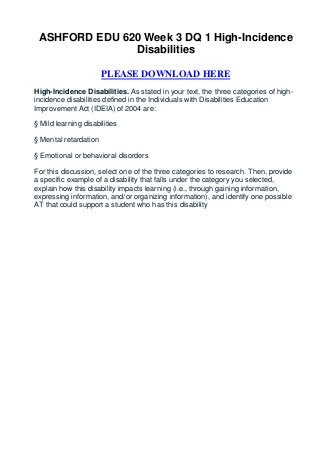Ashford edu 620 week 3 dq 1 high incidence disabilities
•Download as DOCX, PDF•
0 likes•122 views
Report
Share
Report
Share

Recommended
More Related Content
Featured
Featured (20)
Product Design Trends in 2024 | Teenage Engineerings

Product Design Trends in 2024 | Teenage Engineerings
How Race, Age and Gender Shape Attitudes Towards Mental Health

How Race, Age and Gender Shape Attitudes Towards Mental Health
AI Trends in Creative Operations 2024 by Artwork Flow.pdf

AI Trends in Creative Operations 2024 by Artwork Flow.pdf
Content Methodology: A Best Practices Report (Webinar)

Content Methodology: A Best Practices Report (Webinar)
How to Prepare For a Successful Job Search for 2024

How to Prepare For a Successful Job Search for 2024
Social Media Marketing Trends 2024 // The Global Indie Insights

Social Media Marketing Trends 2024 // The Global Indie Insights
Trends In Paid Search: Navigating The Digital Landscape In 2024

Trends In Paid Search: Navigating The Digital Landscape In 2024
5 Public speaking tips from TED - Visualized summary

5 Public speaking tips from TED - Visualized summary
Google's Just Not That Into You: Understanding Core Updates & Search Intent

Google's Just Not That Into You: Understanding Core Updates & Search Intent
The six step guide to practical project management

The six step guide to practical project management
Beginners Guide to TikTok for Search - Rachel Pearson - We are Tilt __ Bright...

Beginners Guide to TikTok for Search - Rachel Pearson - We are Tilt __ Bright...
Ashford edu 620 week 3 dq 1 high incidence disabilities
- 1. ASHFORD EDU 620 Week 3 DQ 1 High-Incidence Disabilities PLEASE DOWNLOAD HERE High-Incidence Disabilities. As stated in your text, the three categories of high- incidence disabilities defined in the Individuals with Disabilities Education Improvement Act (IDEIA) of 2004 are: § Mild learning disabilities § Mental retardation § Emotional or behavioral disorders For this discussion, select one of the three categories to research. Then, provide a specific example of a disability that falls under the category you selected, explain how this disability impacts learning (i.e., through gaining information, expressing information, and/or organizing information), and identify one possible AT that could support a student who has this disability